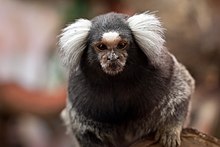Common marmoset
It originally lived on the northeastern coast of Brazil, in the states of Piauí, Paraíba, Ceará, Rio Grande do Norte, Pernambuco, Alagoas, and Bahia.[6] Through release (both intentional and unintentional) of captive individuals, it has expanded its range since the 1920s to Southeast Brazil (its first sighting in the wild for Rio de Janeiro was in 1929), where it became an invasive species, raising concerns about genetic pollution of similar species, such as the buffy-tufted marmoset (Callithrix aurita), and predation upon bird nestlings and eggs.As with other members of the genus Callithrix, the common marmosets have claw-like nails known as tegulae on most of their fingers.Other Callithrix traits shared include enlarged, chisel-shaped incisors and ceca specialized for their diet.They have been introduced into other areas and live within the cities of Rio de Janeiro and Buenos Aires, Argentina.[13] The common marmoset's claw-like nails, incisor shape, and gut specialization reflect their unique diet, which is primarily made of plant exudates and insects.[15] Marmosets also eat fruits, seeds, flowers, fungi, nectar, snails, lizards, tree frogs, bird eggs, nestlings, and infant mammals.Females that mate successfully but lose their young move to other groups and may gain dominant breeding positions.[22][23] Since these suppressed individuals are likely related to the breeding pair, they have an incentive to care for the young, as they share genes with them.The gestation period lasts for 5 months, and females are ready to breed again around 10 days after giving birth.At 5 months, they enter their juvenile stage, when they have more interactions with family members other than their parents, and rough play helps to establish their future status.To signal alarm, aggression, and submission, marmosets use the "partially open mouth stare", "frown", and "slit-stare", respectively.[28] They are used as model organisms in areas of research such as teratology, periodontal disease, reproduction, immunology, endocrinology, obesity, and aging.[8] Segmental duplications added a total of 138 Mb of nonredundant sequences (4.7% of the whole genome), slightly fewer than observed in humans[30][31] or chimpanzees (about 5%),[32] but more than in orangutans (3.8%).





PleistoceneDüsseldorfConservation statusLeast ConcernIUCN 3.1Scientific classificationEukaryotaAnimaliaChordataMammaliaPrimatesHaplorhiniSimiiformesCallitrichidaeCallithrixBinomial nameLinnaeusSynonymsNew World monkeyBrazilPiauíParaíbaCearáRio Grande do NortePernambucoAlagoasRio de Janeiroinvasive speciesgenetic pollutionbuffy-tufted marmosetwhole genome sequencehallucesedge habitatsexudatesinsectsparrotstoucanswoolly opossumsextended familiesErlebnis-Zoo HannoverCerradomodel organismsteratologyperiodontal diseasereproductionimmunologyendocrinologyobesitySegmental duplicationsGroves, C. P.Wilson, D. E.Strier KBIUCN Red List of Threatened SpeciesBibcodeCiteSeerXWikispeciesEnsemblUCSC Genome BrowserBlack-tufted marmoset (C. penicillata)Buffy-headed marmoset (C. flaviceps)Buffy-tufted marmoset (C. aurita)White-headed marmoset (C. geoffroyi)Wied's marmoset (C. kuhlii)Rio Acari marmoset (M. acariensis)Silvery marmoset (M. argentatus)White marmoset (M. leucippe)Emilia's marmoset (M. emiliae)Black-headed marmoset (M. nigriceps)Marca's marmoset (M. marcai)Schneider's marmoset (M. schneideri)Black-tailed marmoset (M. melanurus)Santarem marmoset (M. humeralifer)Maués marmoset (M. mauesi)Munduruku marmoset (M. munduruku)Gold-and-white marmoset (M. chrysoleucos)Hershkovitz's marmoset (M. intermedia)Satéré marmoset (M. saterei)Rondon's marmoset (M. rondoni)Roosmalens' dwarf marmoset (M. humilis)CebuellaEastern pygmy marmoset (C. niveiventris)Western pygmy marmoset (C. pygmaea)LeontopithecusBlack lion tamarin (L. chrysopygus)Golden lion tamarin (L. rosalia)Golden-headed lion tamarin (L. chrysomelas)Superagui lion tamarin (L. caissara)LeontocebusAndean saddle-back tamarin (L. leucogenys)Black-mantled tamarin (L. nigricollis)Brown-mantled tamarin (L. fuscicollis)Cruz Lima's saddle-back tamarin (L. cruzlimai)Geoffroy's saddle-back tamarin (L. nigrifrons)Golden-mantled tamarin (S. tripartitus)Illiger's saddle-back tamarin (L. illigeri)Lesson's saddle-back tamarin (L. fuscus)Red-mantled saddle-back tamarin (L. lagonotus)Weddell's saddle-back tamarin (L. weddelli)SaguinusGolden-handed tamarin (S. midas)Black tamarin (S. niger)Eastern black-handed tamarin (S. ursula)Pied tamarin (S. bicolor)Martins's tamarin (S. martinsi)Cotton-top tamarin (S. oedipus)Geoffroy's tamarin (S. geoffroyi)White-footed tamarin (S. leucopus)Moustached tamarin (S. mystax)White-lipped tamarin (S. labiatus)Emperor tamarin (S. imperator)Mottle-faced tamarin (S. inustus)CallimicoGoeldi's marmoset (C. goeldii)WikidataARKiveiNaturalistObservation.orgOpen Tree of LifePaleobiology DatabaseSpecies+ZooBank